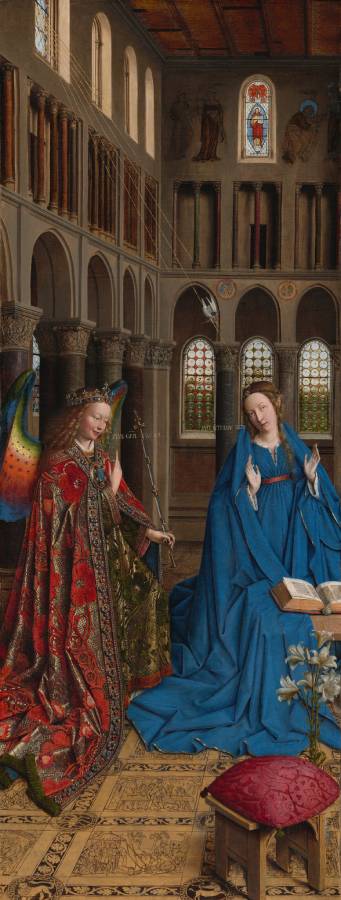Van Eyck, Jan (c.1390-1441)
The Annunciation
c.1434–1436
Oil on canvas transferred from panel, 90.2 x 34.1 cm
National Gallery of Art, Washington
The Annunciation described by Saint Luke is interpreted in terms of actuality in this painting, which was probably once the left wing of a triptych. The forms—even that of the archangel—seem to have weight and volume. Light and shadow play over them in a natural way, and with amazing skill, Jan van Eyck has distinguished between the textures of materials ranging from hard, polished stone to the soft, fragile petals of flowers. Yet religious symbolism speaks from every detail, expounding the significance of the Annunciation, and the relationship of the Old Testament to the New. The structure of the church can be interpreted symbolically; the dark upper story, with its single, stained–glass window of Jehovah, may refer to the former era of the Old Testament, while the lower part of the building, already illuminated by the “Light of the World” and dominated by transparent, triple windows symbolizing the Trinity, may refer to the Era of Grace of the New Testament. The idea of passing from old to new is further manifested in the transition from the Romanesque round–arched windows of the upper story to the early Gothic pointed arches of the lower zone, and also in the depictions on the floor tiles: David beheading Goliath and Samson destroying the Philistine temple are both Old Testament events in the salvation of the Jewish people which prefigure the salvation of humankind through the coming of Christ. A woman and winged angel, both with pale, peach skin, are situated in a church interior in this tall, narrow painting. To our left, the angel has long, blond, curly hair, smooth skin, and is smiling. The wings are outlined in royal blue, and they blend from blue to green to yellow to crimson. The angel holds one hand, closer to us, up at chest height with the index finger subtly pointing upward. Holding a long scepter in the other hand, the angel angles their body toward the woman to our right. The angel wears a gold jewel and pearl-encrusted crown and a jeweled long, voluminous robe in scarlet-red and shimmering gold brocade. The neck and along the opening down the front are lined with pearls and jewels. The angel looks toward the woman, who wears a royal-blue dress tied with a red belt at the high waist. Her long brown hair is tied back but one tendril falls over her left shoulder, to our right. She kneels facing us with her raised hands facing outward. Her head is tipped a bit to our left, and she looks up and into the distance to our right with lips slightly parted. She kneels behind a book lying open on a low table. A vase of white lilies and a red cushion lies on the floor in front of the table, close to us. The floor is decorated with people and scenes outlined in black and set into square panels, as if inlaid with wood. The church behind and above the people has a row of tall, narrow arches with bull’s-eye glass windows. A walkway lined with columns runs above the arches, and sunlight comes in through arched windows under the flat wood ceiling. A white dove flies toward the woman on gold lines from a window at the upper left of the painting. Latin words painted in gold capital letters are exchanged between the people. The angel says, “AVE GRA PLENA.” The letters of the woman’s response are painted upside down and backward: “ECCE ANCILLA DNI.” (NGA)
